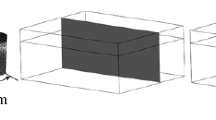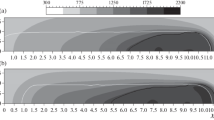Abstract
In this paper an analytical approach to the laser cladding process has been developed and discussed. This approach has taken into account the process speed and feed rate of the powder being supplied for the estimation of clad geometry. The surface tension between the added material and the substrate is used primarily for the calculation of the clad characteristics. The theoretical results are discussed and compared with experimental data. The model is capable of predicting the clad width and depth with reasonable accuracy at low and medium process speeds.
Similar content being viewed by others
References
Chryssolouris G (1991) Laser machining-theory and practice. Springer, Berlin Heidelberg New York
Chryssolouris G (1992) Manufacturing systems-theory and practice. Springer, Berlin Heidelberg New York
Steen WM (1982) Laser cladding, alloying and melting. In: Levitt M, Belforte D (eds) Industrial laser handbook. Springer, Berlin Heidelberg New York, pp 158–171
Yellup JM (1995) Laser cladding using the powder blowing technique. Surf Coat Tech 71:121–128
Chryssolouris G, Zannis S, Tsirbas K, Lalas C (2001) On laser cladding. Proceedings of the 34th international CIRP seminar on manufacturing systems, Athens, Greece, pp 371–380
Konig WE, Rozsnoki L, Kirner P (1992) Laser beam surface treatment-is wear no longer the bug bear of old? In: Mordike BL (ed) 4th European conference of laser treatment of materials, Göttingen, pp 217–222
Picasso M, Marsden CF, Wagniere JD, Frenk A, Rappaz M (1994) A simple but realistic model for laser cladding. Metall Mater Trans B (25B):281–291
Bamberger M, Kaplan WD, Medres B, Shepeleva L (1998) Calculation of process parameters for laser alloying and cladding. J Laser Appl 10(1):29–33
Yevko V, Park CB, Zak G, Coyle TW, Benhabib B (1998) Cladding formation in laser-beam fusion of metal power. Rapid Prototyping J 4(4):168–184
Jouvard JM, Grevey DF, Lemoine F, Vannes AB (1997) Continuous wave Nd:YAG laser cladding modeling: a physical study of track creation during low power processing. J Laser Appl 9:43–50
Toyserkani E, Khajepour A, Corbin S (2003) Three-dimensional finite element modeling of laser cladding by powder injection: effects of powder feedrate and travel speed on the process. J Laser Appl 15(3):153–160
Toyserkani E, Khajepour A, Corbin S (2004) 3-D finite element modeling of laser cladding by powder injection: effects of laser pulse shaping on the process. Opt Laser Eng 41:849–869
Toyserkani E, Khajepour A, Corbin S (2002) Application of experimental-based modeling to laser cladding. J Laser Appl 14(3):165–173
Cho C, Zhao G, Kwak S-Y, Kim CB (2004) Computational mechanics of laser cladding process. J Mater Process Tech 153–154:494–500
Zhao G, Cho C, Kim J-D (2003) Application of 3-D finite element method using Langrangian formulation to dilution control in laser cladding process. Int J Mech Sci 45:777–796
Liu J, Li L (2005) Study on cross-section clad profile in coaxial single-pass cladding with a low-power laser. Opt Laser Technol 37:478–482
Palumbo G, Pinto S, Tricarico L (2004) Numerical and finite element investigation on laser cladding treatment of ring geometries. J Mater Process Tech 155–156:1443–1450
Lin J (1999) Temperature analysis of the powder streams in coaxial laser cladding. Opt Laser Technol 31:565–570
Lin J (1999) A simple model of powder catchment in coaxial laser cladding. Opt Laser Technol 31:223–238
Lin J (2000) Numerical simulation of the focused powder streams in coaxial laser cladding. J Mater Process Tech 105:17–23
Liu C-Y, Lin J (2003) Thermal processes of a powder particle in coaxial cladding. Opt Laser Technol 35:81–86
Fu Y, Loredo A, Martin B, Vannes AB (2002) A theoretical model for laser and powder particles interaction during laser cladding. J Mater Process Tech 128:106–112
Gedda H, Powell J, Wahlstrom G, Li W-B, Engstrom H, Magnusson C (2002) Energy redistribution during CO2 laser cladding. J Laser Appl 14(2):78–82
Chryssolouris G, Zannis S, Tsirbas K, Lalas C (2002) An experimental investigation of laser cladding. Proceedings of the 52nd CIRP general assembly, August, San Sebastian, Spain
Spaepen F (1996) Substrate curvature resulting from the capillary forces of a liquid drop. J Mech Phys Solids 44(5):675–681
Cammarata RC (1997) Surface and interface stress effects on interfacial and nanostructured materials. Mater Sci Eng A 237:180–184
Van De Mark MR (1996) Formula for good wetting. In: Coating R&D notebook. Industrial paint & powder. http://www.ippmagazine.com/articles/1996/columnist96/296col3.htm. Cited 13 January 2006
Holman JP (1997) Heat transfer, 8th edn. McGraw-Hill, New York
Vander Voort GF (2000) Metallography-principles and practice. ASM International, Materials Park, OH
Kelly G, Nagarathnam K, Mazumber J (1998) Laser cladding of cast aluminium-silicon alloys for improved dry sliding wear resistance. J Laser Appl 10(2):45–54
Author information
Authors and Affiliations
Corresponding author
Rights and permissions
About this article
Cite this article
Lalas, C., Tsirbas, K., Salonitis, K. et al. An analytical model of the laser clad geometry. Int J Adv Manuf Technol 32, 34–41 (2007). https://doi.org/10.1007/s00170-005-0318-0
Received:
Accepted:
Published:
Issue Date:
DOI: https://doi.org/10.1007/s00170-005-0318-0




